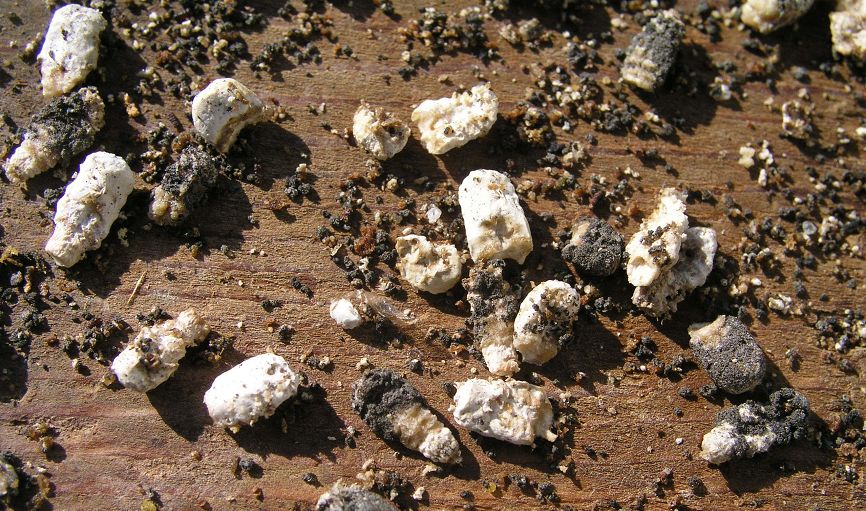Chalkbrood in Honeybees and Leafcutter Bees
Chalkbrood is a serious fungal disease that attacks brood as it develops in the hive. Honeybees are affected by the disease, along with the Blue Orchard bee and the alfalfa leafcutter bee. The disease was first identified in the leafcutter bee and is sometimes called leafcutter chalkbrood.
Alfalfa leafcutter bees originate from Europe and do not build colonies or hives, nor do they make honey. They are solitary, efficient pollinators of alfalfa, carrots, and other fruits and vegetables, which is why some farmers keep them in nest boxes near alfalfa fields.
Whether you’re a traditional beekeeper or a farmer with leafcutter nests, it’s important to know the signs and symptoms of chalkbrood, so you can stop it before it infects all your brood and weakens the colony.
How does a colony become infected?
Chalkbrood spores are prevalent and easily spread. Once they get into a honeybee hive or leafcutter nest box, they spread through the brood rapidly.
The nesting process
Leafcutter colonies live in nest boxes with ridged boards to house new brood. Female bees construct cells from alfalfa leaves and fill them with a ball of pollen, a ball of nectar and one egg. There is enough food for the brood’s entire time in the cell so the female bee never needs to come back to it.
If fungal spores are carried in by adult bees, they can spread to new egg cells. By the time the eggs hatch, the pollen and nectar that make up the cell are filled with spores. The newly-emerged larvae will consume the contaminated food. The spores then germinate in the larvae’s gut and the infection takes over. Once the larvae die, the spores continue to spread through the nest box.
The next summer it is easy for adults to get infected by the remaining spores. While adult alfalfa leafcutter bees aren’t affected by the fungus, they can pass it on to their brood.
Man-made storing of nesting cells
Often alfalfa seed farmers will remove the cells from the nesting boards with the broods and food intact. From here they are transported to usually unsanitary holding bins where they are stored as ‘loose cells’.
Come summertime, these cells are moved to trays covered with screens. The alfalfa farmers incubate these cells to continue the life-cycle and brood growth. Finally, they are left with adult bees emerging. In the time they have been stored and incubated, any chalkbrood spores have spread dramatically and contaminated the loose cells.
Honeybee infection
Honeybees can become infected when they are out collecting pollen. They pick up fungal spores while out and these get introduced into the hive’s food system which is used to feed new brood. As with leafcutters, when the brood is infected, it spreads to adult bees and keeps moving through the colony.
Robber bees or weak colony husbandry can also introduce the fungus into the hive — this allows it to reach the gut of the brood and begin the infection process.
Symptoms of chalkbrood
As chalkbrood spores spread through your hive, you will notice a colour change on the brood. Healthy brood is a glossy white colour, while infected brood is covered in a crust-like exterior. There is both “sporulating” – or spore-spreading – and “non-sporulating” brood.
In the early stages of infection, there will be a chalky white coating on the brood. Later on, sporulating brood will present a brown or black outer while a non-sporulating brood will show a crusted off-white or yellow exterior.
While the spores are microscopic, the sheer number of them and density means you can see them coating the brood.
The final stage of the fungus is mummifying the brood. The brood will harden into a mummy-like appearance and fall from their cells. The mummified larvae are often found gathered in the honey bees’ hive entrance or pollen traps, or at the bottom of leafcutter bees’ nesting boxes.
How to solve your chalkbrood problem
There are several ways to treat honeybee or leafcutter colonies infected with chalkbrood.
Heat treatment
The safest option for the alfalfa leafcutter bee is heat treatment. Use an oven or kiln that is made to circulate heat. Heating nesting material to 93 degrees Celsius will kill chalkbrood spores.
Bleach treatment
For this treatment, you will need bleach or sodium hypochlorite at a five-per cent strength. Dilute 100ml of bleach in 2000ml of water then spray or dip the nest boxes and other equipment in the bleach solution to kill off spores.
Replacement of the queen and the combs
Requeening and replacing the comb is a good treatment option for honeybees. Burning the comb is recommended by some beekeepers as a safe way to ensure the fungus is eradicated. The requeening process should introduce a stronger and more resilient brood population.
Preventing chalkbrood
Preventative measures are the best and healthiest way to protect your bees. To maintain a chalkbrood-free nest or hive you need to do the following:
- Store loose cells safely— make sure to decontaminate any boxes or storage as well as the cells before storing.
- Decontaminate cells, nesting boards and other equipment at least once a year.
- Check nest boxes or hives regularly.
- Keep hives and nest boxes in dry, warm conditions.
For more info on how to spot and treat hive diseases,have a read of our latest blogs.

